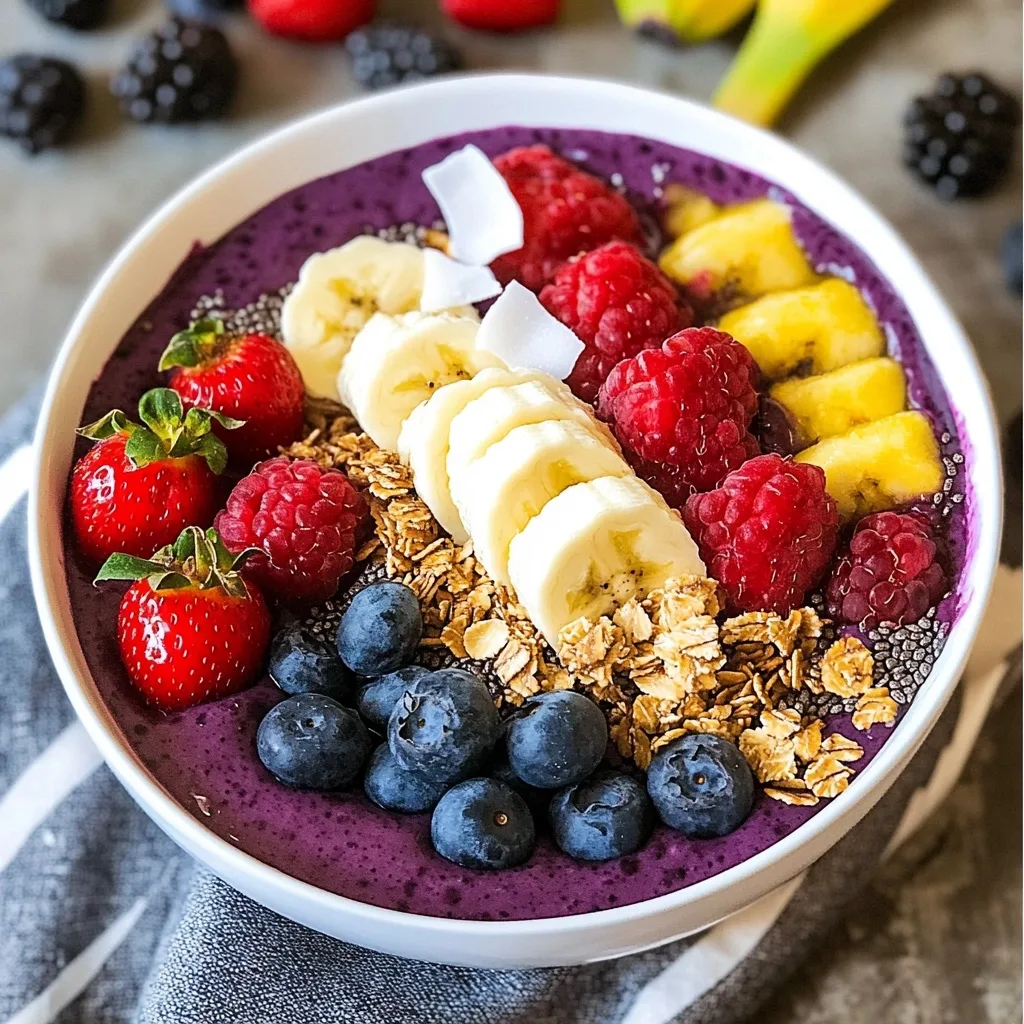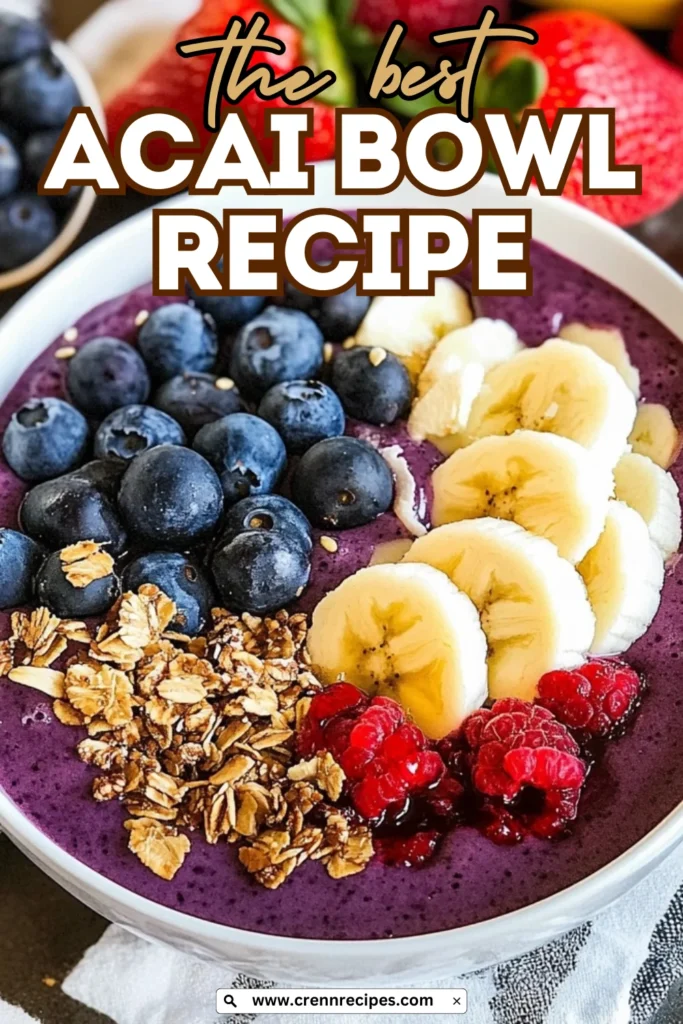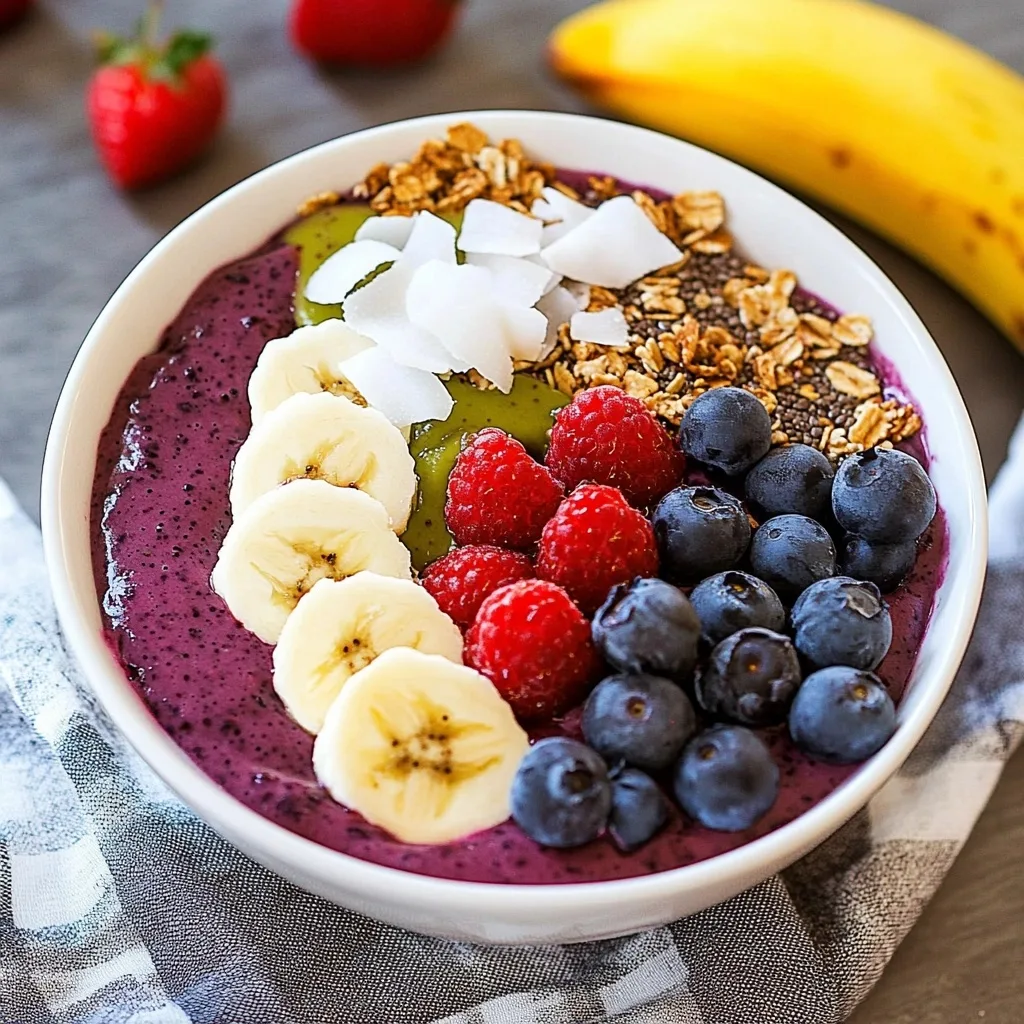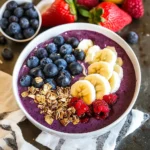This vibrant, nutrient-packed acai bowl combines the antioxidant-rich acai berry with delicious toppings for a refreshing breakfast or snack. Perfect for hot summer days or post-workout recovery, this Instagram-worthy purple smoothie bowl will energize your mornings while satisfying your sweet tooth the healthy way.
Introduction: Discovering the Acai Bowl Phenomenon
Acai bowls have taken the breakfast and healthy eating world by storm, and for good reason. These vibrant purple creations aren’t just eye-catching—they’re packed with nutrients, versatile enough to customize endlessly, and most importantly, absolutely delicious. If you’ve ever walked past a trendy juice bar or scrolled through Instagram’s health food tags, you’ve undoubtedly seen these photogenic purple smoothie bowls topped with artfully arranged fruit, granola, and seeds.
But what exactly is acai, and why has it become such a sensation in the health food community? The acai (pronounced ah-sigh-EE) berry comes from acai palm trees native to the rainforests of South America, particularly Brazil. These small, dark purple berries have been a staple in the diets of indigenous Amazon populations for centuries, but they’ve only recently captured global attention for their impressive nutritional profile and unique flavor.
Fresh acai berries are rarely available outside their native region because they’re highly perishable. Instead, you’ll typically find acai as frozen pulp, powder, or juice. The flavor is often described as a cross between wild berries and chocolate—slightly tart, somewhat earthy, with subtle cocoa notes. This distinctive taste, combined with acai’s creamy texture when blended, creates the perfect base for a smoothie bowl.
What sets acai bowls apart from regular smoothies is their thicker, spoonable consistency and the beautiful canvas they provide for nutritious and colorful toppings. Making an acai bowl at home lets you control the ingredients, sugar content, and portion size—all while saving money compared to cafe versions that can cost upwards of $12.
In this comprehensive guide, I’ll walk you through creating the perfect acai bowl at home, from selecting ingredients to mastering the blending technique, plus share creative variations and topping ideas that will keep your breakfast exciting day after day. Whether you’re an acai bowl aficionado or trying this superstar breakfast for the first time, you’re in for a treat that’s as nutritious as it is delicious.
The Health Benefits of Acai Bowls
Acai: The Purple Powerhouse
The star ingredient in our bowl isn’t just pretty—it’s packed with impressive health benefits that have earned it “superfood” status. Acai berries are nutritional powerhouses containing:
Antioxidants: Acai berries have an exceptionally high antioxidant content, even higher than blueberries, strawberries, and other antioxidant-rich fruits. These compounds help combat oxidative stress and free radicals in the body, potentially reducing inflammation and supporting overall health.
Healthy Fats: Unlike many fruits, acai berries contain healthy monounsaturated fats similar to those found in avocados and olive oil. These fats support heart health, brain function, and help keep you feeling satisfied longer.
Fiber: Acai contains significant dietary fiber, which supports digestive health, helps maintain healthy blood sugar levels, and contributes to that feeling of fullness that makes acai bowls so satisfying as a meal.
Vitamins and Minerals: Acai provides calcium, vitamin A, and various plant compounds that support immune function, skin health, and cellular protection.
Complete Nutritional Profile
When you combine acai with other ingredients in our recipe, the nutritional benefits multiply:
Banana: Adds potassium for muscle function and heart health, plus natural sweetness and creamy texture.
Berries: Contribute additional antioxidants, vitamin C, and fiber while keeping sugar content lower than many fruit-based breakfasts.
Almond Milk: Provides a dairy-free base with vitamin E and calcium, depending on the brand.
Granola and Seeds: Add vital protein, healthy fats, and crunch factor with omega-3 fatty acids from chia or flax seeds.
Coconut: Offers medium-chain triglycerides (MCTs), which some studies suggest may support brain function and energy levels.
A typical acai bowl serving contains approximately 350-500 calories, depending on toppings, making it an appropriate breakfast option that will keep you energized through the morning. The balanced combination of complex carbohydrates, healthy fats, and moderate protein creates a nutrient-dense meal that won’t lead to the sugar crash often associated with many breakfast options.
It’s worth noting that while acai bowls are nutrient-rich, they can also be high in natural sugars from the fruits. If you’re monitoring your sugar intake, you can adjust the recipe by using less banana and being mindful of topping choices. The beauty of making acai bowls at home is the complete control you have over the ingredients and portions.

Essential Ingredients Breakdown
The Base Components
Creating the perfect acai bowl starts with selecting quality ingredients for the base:
Frozen Acai Puree: The foundation of any authentic acai bowl. Look for unsweetened packets in the frozen section of natural food stores or some conventional supermarkets. Popular brands include Sambazon, Acai Roots, and Amazon Planet. Avoid acai products with added sugar or guarana if you’re looking to control the sweetness yourself.
Frozen Banana: Provides natural sweetness and creates that thick, ice cream-like consistency that makes acai bowls so satisfying. For the best texture, slice and freeze ripe bananas (with speckles on the peel) at least 4 hours before making your bowl.
Frozen Mixed Berries: Enhance the berry flavor while adding additional antioxidants and nutrients. The frozen state helps achieve that thick smoothie bowl texture without watering it down with ice.
Almond Milk: Adds just enough liquid to help the blender process the frozen ingredients while keeping the mixture thick. Unsweetened varieties let you control the sugar content. Substitute with coconut milk for tropical flavor, oat milk for creaminess, or any milk of your preference.
Natural Sweetener: Honey or agave nectar adds adjustable sweetness. Maple syrup or date syrup are excellent alternatives, each bringing their unique flavor profiles to complement the acai.
Topping Selection
The toppings aren’t just for Instagram-worthy presentations—they add texture, additional nutrients, and flavor complexity:
Granola: Provides satisfying crunch and staying power through added protein and fiber. Choose varieties with minimal added sugars, or make your own for complete control over ingredients.
Fresh Fruit: Adds fresh contrast to the frozen base, visual appeal, and additional vitamins. Slice bananas thinly for elegant presentation, halve strawberries, or scatter whole blueberries for pops of color.
Shredded Coconut: Contributes tropical notes and texture variation. Toasted coconut brings out nutty flavors, while unsweetened varieties keep the sugar content in check.
Seeds: Chia and flax seeds pack a nutritional punch with omega-3 fatty acids and fiber. They add subtle crunch and help keep you full longer.
Optional Additions: Consider these extra toppings for variety:
- Nut butters (almond, peanut, or cashew) for protein and rich flavor
- Cacao nibs for antioxidants and chocolate notes without added sugar
- Bee pollen for subtle sweetness and potential allergy relief benefits
- Hemp hearts for complete protein and nutty flavor
- Goji berries for chewy texture and additional antioxidants
The quality of your ingredients directly impacts the final result. Where possible, choose organic berries (particularly for the “dirty dozen” like strawberries) and read labels on prepared ingredients like granola to avoid unnecessary additives or excess sugars.
Step-by-Step Preparation Guide
Mastering the Perfect Blend
Creating that ideal acai bowl consistency requires attention to detail and proper technique:
- Prepare Your Ingredients: Break the frozen acai packets into chunks by gently hitting the sealed packet against your counter or briefly running under warm water. This makes it easier for your blender to process them.
- Layer Strategically: Add ingredients to your blender in this order for the smoothest blending:
- Liquid (almond milk) at the bottom
- Softer frozen items (banana)
- Harder frozen items (mixed berries and acai chunks)
- Blending Technique: Start on low speed to break down the frozen chunks, then gradually increase to high speed. Use the tamper if your blender has one, or stop occasionally to scrape down the sides.
- Texture Check: The perfect consistency should be somewhere between a thick smoothie and soft-serve ice cream. You should be able to scoop it with a spoon, and it should hold its shape without being runny. If the mixture is too thick to blend, add almond milk one tablespoon at a time—but be patient before adding more liquid, as over-blending can quickly make it too thin.
- Troubleshooting: If your mixture becomes too thin, add more frozen fruit. If it’s too thick, add small amounts of liquid. Remember that a slightly thicker blend is better than too thin, as the acai mixture will naturally soften slightly at room temperature.
The Art of Assembly
Presentation transforms your acai bowl from simple breakfast to culinary creation:
- Serving Bowl Selection: Choose a wide, shallow bowl that provides ample surface area for toppings. Chilled bowls help keep your acai mixture from melting too quickly.
- Base Distribution: Transfer the blended acai mixture to your bowl using a silicone spatula to get every bit of that purple goodness. Smooth the top with the back of a spoon, creating a level surface for your toppings.
- Topping Arrangement: There are two schools of thought for topping placement:
- Sectioned approach: Divide the bowl visually into quadrants, placing different toppings in each section for a beautiful presentation and allowing you to enjoy different flavor combinations with each spoonful.
- Layered approach: Start with granola as a foundation, then add sliced fruits, finishing with smaller toppings like seeds and coconut.
- Artistic Touches: For a professional look, arrange banana slices in a fan pattern along one side, place larger berries strategically for color contrast, and sprinkle smaller ingredients like chia seeds or coconut in a fine layer over specific areas rather than the entire bowl.
- Final Flourishes: Consider a light drizzle of honey in a spiral pattern or a dusting of cinnamon for added visual appeal and flavor enhancement.
The key to a successful acai bowl is serving it immediately after preparation. Unlike smoothies that can be made ahead, acai bowls are best enjoyed fresh to maintain that perfect scoopable texture and prevent toppings from becoming soggy.

Customization and Variations
Flavor Profile Adaptations
One of the joys of acai bowls is their versatility. Here are some delicious variations to keep your breakfast exciting:
Tropical Paradise Bowl: Replace mixed berries with frozen pineapple and mango. Top with fresh kiwi slices, passion fruit, and toasted coconut for a vacation in a bowl.
Chocolate Lover’s Bowl: Add a tablespoon of unsweetened cocoa powder to the base mixture. Top with cacao nibs, sliced banana, and a small drizzle of almond butter for a healthy version of a chocolate sundae.
Green Machine Bowl: Incorporate a handful of spinach or kale into your base (it won’t significantly alter the taste but adds nutrition). Top with kiwi, green apple slices, and pistachios for a verdant variation.
Protein-Packed Bowl: Blend in a scoop of your favorite protein powder (vanilla works well with acai). Top with higher-protein additions like Greek yogurt, hemp seeds, and a sprinkle of quinoa granola.
Seasonal Specialties: Adapt your bowls to showcase the best of each season:
- Spring: Strawberries, mint, and pistachios
- Summer: Peaches, blueberries, and basil
- Fall: Apples, cinnamon, and pumpkin seeds
- Winter: Pear, pomegranate seeds, and warming spices
Dietary Accommodations
Acai bowls are naturally vegetarian and can easily be adapted for various dietary needs:
Vegan Version: Already nearly there—just ensure your granola is vegan and use maple syrup instead of honey as a sweetener.
Nut-Free Option: Substitute oat milk or coconut milk for almond milk. Replace granola containing nuts with a seed-based variety or toasted oats. Use sunflower seed butter instead of nut butters.
Low-Sugar Adaptation: Reduce or eliminate the added sweetener, use a smaller portion of banana, and choose toppings like unsweetened coconut and berries rather than higher-sugar fruits like mango.
Paleo-Friendly: Top with grain-free granola made with nuts and seeds, use coconut milk as your liquid base, and sweeten with a minimal amount of raw honey.
No matter how you customize your acai bowl, maintaining the proper texture is key. Remember that adding ingredients like protein powder may change the consistency, requiring slight adjustments to the liquid ratio.
Storage and Make-Ahead Tips
Preparing Components in Advance
While acai bowls are best assembled just before eating, you can streamline the morning process:
Freezer Smoothie Packs: Prepare individual freezer bags containing all frozen ingredients (acai, banana, and mixed berries). In the morning, simply empty a bag into the blender, add liquid, and blend.
Topping Stations: Store topping options in clear containers in your pantry or refrigerator, creating a “build your own acai bowl” setup that’s especially fun for families.
Granola Prep: Make a large batch of homemade granola to use throughout the week. Store in an airtight container to maintain freshness and crunch.
Enjoying Leftover Acai Base
If you make too much acai base or want to prepare extra for later:
Frozen Treats: Pour leftover acai mixture into popsicle molds for refreshing frozen treats.
Next-Day Rescue: If you have leftover blended acai base, store it in an airtight container in the freezer. When ready to enjoy, let it thaw slightly, then re-blend with a small amount of liquid to restore the smooth texture.
Smoothie Conversion: Thin leftover acai base with additional almond milk to transform it into a drinkable smoothie.
Remember that the texture of frozen and re-blended acai won’t be quite the same as fresh, but these strategies help minimize waste while still enjoying the flavors and benefits.

Nutritional Information and Health Considerations
Macronutrient Breakdown
Understanding the nutritional profile helps you incorporate acai bowls into a balanced diet:
A standard acai bowl following our recipe provides approximately:
- Calories: 380-450 (depending on toppings)
- Protein: 5-7g
- Carbohydrates: 65-75g
- Fiber: 10-12g
- Fat: 14-18g (primarily healthy unsaturated fats)
- Sugar: 35-40g (mostly from natural fruit sugars)
This nutritional profile makes acai bowls a balanced breakfast option with substantial fiber to slow digestion and healthy fats for satiety. The protein content is moderate—if you’re looking to increase protein, consider adding Greek yogurt, protein powder, or more seeds and nut butter.
Who Should Enjoy Acai Bowls?
Acai bowls can benefit various groups:
Active Individuals: The carbohydrate content provides excellent energy for morning workouts or recovery afterward, while antioxidants help combat exercise-induced free radicals.
Plant-Based Eaters: Delivers important nutrients that can sometimes be challenging to obtain on plant-based diets, including healthy fats and antioxidants.
Children: A naturally sweet breakfast or snack that provides significant nutritional value compared to most kid-targeted breakfast options. Consider smaller portions and involving kids in the topping selection process.
Those Seeking Digestive Health: The fiber content from fruits, seeds, and granola supports digestive health and microbiome balance.
Mindful Considerations
While acai bowls offer numerous benefits, they may not be ideal for everyone in all circumstances:
Blood Sugar Sensitivity: The natural sugar content, even without added sweeteners, may be high for those with diabetes or blood sugar regulation concerns. Consider reducing high-sugar fruits and increasing healthy fat components like nut butter or seeds.
Calorie Density: Though nutrient-dense, acai bowls can be calorie-dense, especially when topped liberally. If weight management is a goal, be mindful of portion sizes, particularly with granola and nut butter additions.
Allergens: Common acai bowl ingredients like nuts, seeds, and certain fruits may be allergens for some individuals. Always check ingredients in store-bought granola if allergies are a concern.
As with any food, moderation and personalization are key. Acai bowls can be a nutritious part of a varied diet, providing excellent nutrient diversity and satisfaction.
Serving Suggestions and Pairings
Complete Breakfast Ideas
Transform your acai bowl from a standalone dish to part of a complete breakfast experience:
Protein Boost: Serve alongside a soft-boiled egg or a small portion of Greek yogurt to increase protein content for a more filling meal.
Hydration Pairing: Accompany with herbal tea, cold-pressed juice, or infused water for a restaurant-quality breakfast spread.
Weekend Brunch: Create an acai bowl bar with multiple topping options alongside other brunch favorites for an impressive and interactive meal when entertaining.
Timing and Occasions
Acai bowls aren’t just for breakfast—consider these alternative serving opportunities:
Post-Workout Recovery: The combination of carbohydrates and antioxidants makes acai bowls excellent for muscle recovery and energy replenishment after exercise.
Afternoon Snack: A smaller portion serves as a perfect 3 PM pick-me-up that won’t leave you crashing before dinner.
Dessert Alternative: Serve a slightly smaller portion as a healthier dessert option that satisfies sweet cravings while providing nutritional benefits.
Summer Entertaining: Offer individual acai bowls as a refreshing option for summer brunches or pool parties—they’re especially welcome on hot days.
The vibrant color and impressive presentation make acai bowls suitable for special occasions, while their simple preparation makes them accessible for everyday enjoyment.
Frequently Asked Questions About Acai Bowls
Common Troubleshooting and Queries
Q: Why is my acai bowl too runny?
A: The most common causes are using too much liquid, over-blending, or not using enough frozen ingredients. Try using less almond milk next time, ensuring all fruit is thoroughly frozen, and pulsing rather than continuous blending. If you’ve already made a runny mixture, add more frozen fruit or even a few ice cubes to thicken it back up.
Q: Can I use acai powder instead of frozen puree?
A: Yes, acai powder works as an alternative. Use about 1-2 tablespoons of acai powder in place of the frozen packets. Since you’re losing the volume and frozen element of the puree, you’ll need to add more frozen fruit to compensate, such as additional frozen berries or banana.
Q: How do I make my acai bowl sweeter without adding sugar?
A: Try these natural sweetening strategies: use very ripe bananas (with brown speckles); add naturally sweet fruits like mango or pineapple; incorporate a few soft dates into the blend; or top with a sprinkle of cinnamon, which enhances perceived sweetness without adding sugar.
Q: Why are my acai bowls so expensive to make at home?
A: While the initial investment in acai packets may seem high compared to other frozen fruits, consider that homemade bowls are still typically half the price of café versions. To economize, buy acai packets in bulk when on sale, use seasonal fresh fruits for toppings, and make your own granola from bulk-bin ingredients.
Q: Can children eat acai bowls?
A: Acai bowls can be excellent nutritious options for children. Consider making smaller portions, involving kids in the assembly process to increase interest, and avoiding potential choking hazards like whole nuts or large seeds for very young children. The natural sweetness and vibrant color tend to appeal to kids without resorting to artificial ingredients.
Conclusion: Perfecting Your Acai Bowl Experience
The beauty of acai bowls lies in their balance of nutrition and indulgence. What begins as a simple blend of frozen fruits transforms into a nourishing meal that feels like a treat. The vibrant purple base provides a canvas for creative expression through toppings, making each bowl a unique culinary experience.
By mastering the techniques in this guide—from achieving that perfect spoonable texture to artfully arranging toppings—you’ve gained the skills to create café-quality acai bowls in your own kitchen. The cost savings are significant, but the true value comes from controlling the ingredients, customizing to your preferences, and sharing this nutritious creation with family and friends.
As you experiment with different variations and find your favorite combinations, you’ll discover that acai bowls can be much more than a trending breakfast food—they can become a nourishing ritual that brings a moment of joy to your morning routine. The time spent mindfully preparing and savoring your creation becomes a form of self-care in our often rushed modern lives.
Whether you’re drawn to acai bowls for their nutritional benefits, their photogenic appearance, or simply their delicious taste, you now have all the knowledge needed to create your perfect bowl. So gather your ingredients, fire up the blender, and treat yourself to a breakfast that nourishes body and soul.
More Related Recipes You Might Enjoy
- Classic Vanilla Berry Chia Pudding – Another superfood breakfast featuring berries and nutritious seeds
- Greek Yogurt Parfait – A protein-rich layered breakfast with similar fresh fruit toppings
- Breakfast Burrito Bowl – A savory alternative that maintains the versatile bowl format perfect for customization

Acai Bowl Recipe: 7 Incredible Health Benefits of This Amazing Superfood
- Total Time: 10 minutes
- Yield: 1 serving 1x
- Diet: Vegetarian
Description
A vibrant, nutrient-packed acai bowl combining frozen acai puree with banana and mixed berries for a refreshing breakfast or snack. Topped with fresh fruits, granola, coconut, and seeds for added texture and nutrition.
Ingredients
- 2 packs (100g each) frozen unsweetened acai puree
- 1 ripe banana (frozen if you like it extra thick)
- ½ cup frozen mixed berries (strawberries, blueberries, raspberries)
- ⅓ cup unsweetened almond milk (or your milk of choice)
- 1 tablespoon honey or agave nectar (optional, for sweetness)
- ¼ cup granola (choose your fav family recipe or store-bought)
- 2 tablespoons shredded coconut
- ½ cup fresh sliced banana
- ¼ cup fresh berries (blueberries & strawberries)
- 1 tablespoon chia seeds or flax seeds
Instructions
- In your high-speed blender, add the frozen acai packs (break them up a bit first), frozen banana, mixed berries, and almond milk.
- Drizzle in the honey or agave if you prefer your bowl on the sweeter side.
- Blend on high until smooth and thick—aim for a soft-serve texture you can scoop with a spoon.
- Spoon the purple blend into a bowl, leveling it off for even topping distribution.
- Sprinkle granola in the center or arrange in neat lines.
- Scatter the fresh sliced banana and berries around the granola for pops of color.
- Finish with shredded coconut and chia seeds for crunch and added nutrition.
- Serve immediately while chilled for best texture and flavor.
Notes
- Use frozen fruits for the base to achieve the perfect thick, scoopable consistency.
- For extra thickness, freeze the banana overnight.
- Customize with your favorite toppings—try adding nut butter, cacao nibs, or goji berries.
- Consume immediately after preparation, as acai bowls tend to melt quickly.
- To make ahead, prepare freezer packs with all frozen ingredients portioned for single servings.
- Prep Time: 10 minutes
- Cook Time: 0 minutes
- Category: Breakfast
- Method: Blending
- Cuisine: Brazilian-inspired
Nutrition
- Serving Size: 1 bowl
- Calories: 420
- Sugar: 38g
- Sodium: 45mg
- Fat: 16g
- Saturated Fat: 5g
- Unsaturated Fat: 10g
- Trans Fat: 0g
- Carbohydrates: 68g
- Fiber: 12g
- Protein: 7g
- Cholesterol: 0mg

